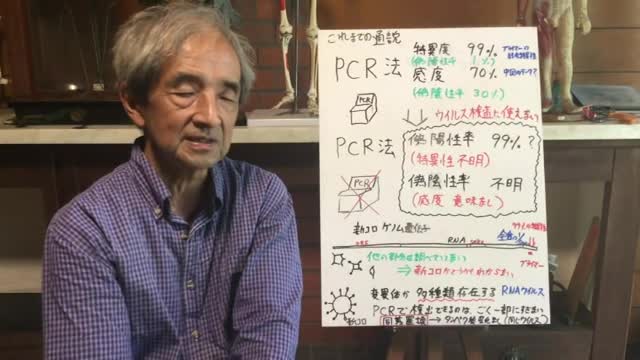Premium Only Content

【124】「PCRは、感染症の検査に使ってはならない」マリス博士の伝えたかったこと - 大橋眞
PCRは、遺伝子の断片を調べるものであり、病原体ウイルスを検査ことには、適していません。PCRが、感度と特異性が非常に高いために、病原体ウイルスの検査にも使えるという誤解があるようです。PCRの発明者キャリーマリスも、PCRは、感染症の検査に使ってはならない」という趣旨の発言をされていたようです。この発言の出処について議論があるようですが、この発言の意味についてはあまり議論がされていません。今回の騒動の中心的役割を果たしているPCR検査の何が問題なのかを明らかにすることが必要です。
PCRの検査する遺伝子断片は、わずか100塩基ほどの長さであり、PCRの高い特異性は、この範囲内のことにすぎません。全長3万塩基の新コロゲノムの300分の1に過ぎないのです。残りの300分の299の領域について、何の情報も得ることはできないのです。300分の1が似ているからと言って、全体が似ているという保証はどこにもないわけです。むしろ、病原性は強いといって恐れているウイルスを保有していれば、多くのPCR陽性者が無症状であるという事実と説明できません。PCRは、新コロウイルス以外のウイルスを引っかけていると考えたほうが自然です。ウイルス数も少ないことからも、病原性を有するとは考えられません。現在のPCR陽性者は、ほとんどが偽陽性の可能性が高いのです。これを明らかにするために残りの300分の299の情報を開示する必要があります。現在無症状感染者がたくさん出ているわけですから、その情報を集めることはできるはずです。もし、仮に完全に中国論文と一致したとしても、その病原性の確認が重要です。無症状と病原性の関係を明確にする必要があります。
また、たんぱく質の構造に変化を与えない遺伝子の同義的置換は、理論的には、非常に多くの変異体があることになります。PCRで、確認できるのは、この変異体のごく一部に過ぎません。すなわち偽陰性が非常に多く発生する可能性があるのです。すべての変異体を検出するには、数万種以上のプライマーで検査を行う必要があります。しかし、これは実際には不可能でしょう。そのために、多量の偽陰性の発生は、避けられないのです。
このような偽陽性、偽陰性を防ぐには、PCRに反応するウイルスの現地調査、変異体の存在の地域分布などをあらかじめ調べておく必要があります。遺伝子バンクに登録されているのは、病原性ウイルスなど医学的に重要なものだけです。それ以外の無数とも言える常在ウイルスについては、遺伝子バンクには、基本的に何の情報もないのです。PCRを病原体ウイルスの検査に使うためには、このような地域ごとのウイルス分布についての基礎調査が必須です。しかし、このような調査は、莫大なお金と時間が必要です。病原性もよくわからないウイルスの調査を、莫大な予算をつかっておこなうのは現実的ではありません。したがって、PCRは、病原体ウイルスの検査に使えないのです。マリス博士の発言には、このような背景があるのです。
PCR looks for fragments of a gene and is not suitable for testing pathogen viruses. There seems to be a misconception that PCR can also be used to test for pathogen viruses due to its extremely high sensitivity and specificity. Carrie Maris, the inventor of PCR, also seems to have said that PCR should not be used for testing for infectious diseases. " There seems to be some debate about the source of this statement, but there is not much discussion about the meaning of this statement. It is necessary to clarify what is wrong with the PCR test that plays a central role in this uproar.
The gene fragment to be tested by PCR is only about 100 bases in length, and the high specificity of PCR is only within this range. It is only 1/300 of the new corogenome with a total length of 30,000 bases. No information is available for the remaining 299/300 areas. Just because one-third is similar doesn't mean that the whole thing is similar. Rather, it cannot be explained by the fact that many PCR-positive individuals are asymptomatic if they carry a virus that they fear is highly pathogenic. It is more natural to think that PCR is catching viruses other than the new corovirus. Due to the low number of viruses, it is not considered to be pathogenic. Most current PCR-positive individuals are likely to be false-positive. To clarify this, we need to disclose the remaining 299/300 information. There are many asymptomatic infected people now, so we should be able to collect that information. Even if it is completely consistent with the Chinese treatise, it is important to confirm its pathogenicity. The relationship between asymptomatic and pathogenicity needs to be clarified.
In addition, synonymous substitution of genes that do not change the structure of proteins theoretically means that there are a large number of mutants. Only a small portion of this mutant can be confirmed by PCR. That is, false negatives can occur very often. To detect all mutants, it is necessary to test with tens of thousands of primers. But this wouldn't really be possible. Therefore, the occurrence of large numbers of false negatives is inevitable.
In order to prevent such false positives and false negatives, it is necessary to investigate in advance the field survey of viruses that react with PCR and the regional distribution of the presence of mutants. Only medically important viruses such as pathogenic viruses are registered in the gene bank. There is basically no information in the gene bank about the myriad of other indigenous viruses. In order to use PCR for testing pathogen viruses, it is essential to conduct a basic survey on the virus distribution in each region. However, such research requires enormous amounts of money and time. It is not realistic to spend a huge budget to investigate a virus whose pathogenicity is not well understood. Therefore, PCR cannot be used to test for pathogen viruses. This is the background of Dr. Maris' remarks.
-
 LIVE
LIVE
The Rubin Report
38 minutes agoPress Stunned by Trump’s Brutally Honest Message for Elon Musk
1,325 watching -

VINCE
2 hours agoEpstein Victims Have Come Forth, The Names Have Not | Episode 118 - 09/04/25
59.8K36 -
 LIVE
LIVE
LFA TV
4 hours agoLFA TV ALL DAY STREAM - THURSDAY 9/4/25
4,553 watching -
 LIVE
LIVE
Badlands Media
5 hours agoBadlands Daily: September 4, 2025
3,973 watching -

Dear America
2 hours agoEpstein Victims Vow To EXPOSE Everyone! + Are China and Russia Planning Against Trump?!
88.2K44 -
 LIVE
LIVE
Law&Crime
2 hours ago $1.06 earnedLIVE: Adelson Matriarch Murder Trial — FL v. Donna Adelson — Day 9
234 watching -
 LIVE
LIVE
The Big Mig™
1 hour agoCartels Are On Borrowed Time, Here Comes The BOOM!
4,354 watching -
 LIVE
LIVE
Matt Kohrs
12 hours agoMASSIVE Market Swings Incoming! || Top Futures & Options Trading Show
521 watching -
 LIVE
LIVE
Wendy Bell Radio
6 hours agoIt's All About the Benjamins
7,145 watching -
 LIVE
LIVE
JuicyJohns
2 hours ago $2.89 earned🟢#1 REBIRTH PLAYER 10.2+ KD🟢
88 watching